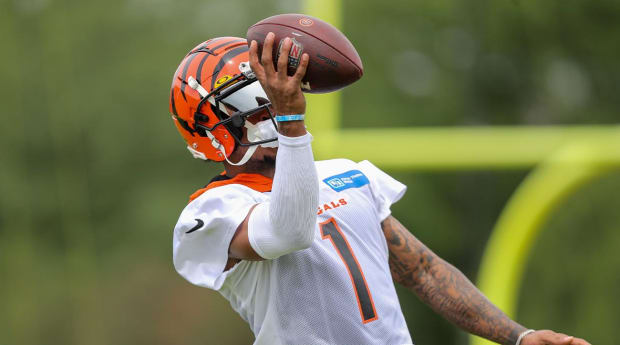For fantasy football managers who want more control building their teams than they might get with a draft, auction formats are the way to go. The most common format features a $200 budget for a 20-man roster in 12-team leagues. Each team will start a quarterback, two running backs, three wide receivers, one tight end, a kicker and a defense. Flex position (RB/WR/TE) is the standard in the high-stakes market. The most progressive formats offer two flex spots instead of three wideouts. By using this setup, a team has a better chance of covering an injury at wide receiver with their running back depth or even a second viable tight end.
Game plan
The first order of business is developing a plan for your team structure. One decision is whether to invest the bulk of your budget into your starting lineup or build a core of players while saving enough money to secure multiple bench players with upside.
An aggressive manager may invest between $160-180 in his or her starting lineup. Those looking to be more balanced might try to spend around $150 on their starting lineup while not purchasing any big-ticket items.
Based on my experience, sacrificing the quarterback position can be the best way to shift money to other parts of your roster. For example, Josh Allen at $21 seems like a great buy at the National Fantasy Football Championship, but the 12th-ranked quarterback costs about $4. So for someone looking to push the envelope even further, they could pick up three quarterbacks for a combined $3. The quarterback position offers the highest floor of fantasy points in the free agent pool, and many low-dollar buys will have better-than-expected seasons.
By saving $17 at quarterback, a team can have valuable over bids to win critical battles later in the auction.
When I arrive at my auctions, I want to identify one foundation running back plus my top two options at wide receiver. Typically, I’m looking for a high floor, and I’m willing to pay for it. I then want to have a couple of options to start at RB2. In addition, I’ll have a plan at quarterback and tight end. Finally, my early spending will determine my best options at WR3 and the flex position.
View the original article to see embedded media.
Player calls
I’m of the opinion that I want my targeted players on the table as quickly as possible in auctions. By doing this, I find out early the cost of my targeted players. If I miss on a desired player, I’ll have more options to adjust my plan. By waiting for the natural flow, I will be passing potential opportunities while leaving me fewer outs if someone outbids me on my top targets.
When I sit at the auction table, I have a pretty good idea of what most top players will cost. Therefore, I will call out my top targets the first chance I get. This theory works well at positions where there are multiple players with similar value and interest. Often, the first of a grouping can lead to less fight in the auction.

Katie Stratman-USA TODAY Sports
Here’s an example:
Cooper Kupp, Justin Jefferson and Ja’Marr Chase are the top three wideouts selected in most drafts this year. If I target Chase ($47 in the early auctions in the NFFC) and I call him out first, many other opponents will believe they can win Jefferson or Kupp. Therefore, Chase should cost somewhere in my projected range. However, if I wait for Chase to be called out, Jefferson, Kupp and other wideouts could already be purchased. This situation may lead to a much higher cost than expected for Chase.
Early spender
An aggressive style of team development requires an auction player to be disciplined after buying his core players. The goal is to keep an open mind on potential buys in the middle of the auction while also trying to wait long enough to finish your roster when your team has the edge in spending.
Value shopper
For someone with hard breakpoints on player values, it is essential not to invest in too many players with similar values. Making correct roster decisions is an integral part of winning in fantasy football. A team with no clear RB1, RB2, WR1 and WR2 will be flipping a coin on who to start in many weeks. This type of scenario happens a lot to a team developed with 8-10 players, with costs between $15 and $20. My goal in building my rosters is to eliminate as many decisions on Sunday as possible.
View the original article to see embedded media.
End game
In fantasy football, the player pool tends to fall off after 144 players, except for backup quarterbacks and tight ends. Most teams will select one kicker and one defense, each with minimal costs. Essentially, your final five players on your roster could cost you less than $10. The key to developing your bench is the players bought that typically get selected between rounds 9-12 in drafts. These players will be needed to cover injuries and bye weeks.
In the end, a team needs to score about 145.0 fantasy points to be a contender in the league. There are many ways to develop a roster, and what works in one season may not work the next.
If I were doing an auction, here’s a look at my targeted team with my prices pulled from the NFFC:
QB: Joe Burrow ($7), Tua Tagovailoa ($2)
RB: Travis Etienne ($32), AJ Dillon ($17), Rhamondre Stevenson ($12), James Cook ($8), Kenneth Gainwell ($5), Rachaad White ($4)
WR: Ja’Marr Chase ($47), Amon-Ra St. Brown ($17), Juju Smith-Schuster ($15), De’Andre Hopkins ($10), Robert Woods ($7), Joshua Palmer ($4), Amari Rodgers ($1)
TE: T.J. Hockenson ($8), Hunter Henry ($2)
K: Will Lutz ($1)







